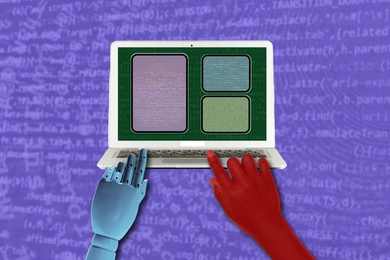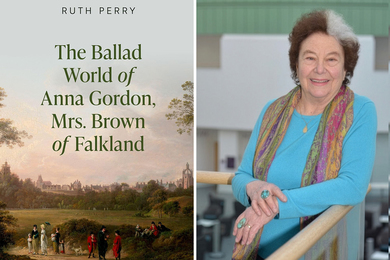Faculty discussion of the proposed undergraduate curriculum changes began in earnest at the Oct. 18 faculty meeting, following the Oct. 13 release of the Institute's Task Force on the Undergraduate Educational Commons report outlining its recommended changes.
At the Nov. 15 faculty meeting, the deliberations will continue and the faculty will consider a motion that would delay until February the vote on whether the recommendations as they stand should be turned over to the Faculty Committee on the Undergraduate Program (CUP) for refinement.
The recommendations, which include new requirements in science, mathematics and engineering as well as in the humanities, arts and social sciences, also endorse an increased role for international educational experiences in the undergraduate years.
The task force, which worked on the recommendations for two and a half years, was chaired by Robert J. Silbey, MIT's Class of 1942 Professor of Chemistry and dean of science.
Silbey said the task force's assignment was challenging. Previous changes to the general Institute requirements (GIRs) occurred in 1964, when the world--and MIT--was a very different place. There were no personal computers then, he pointed out, and the student body represented a predominantly Caucasian male demographic. The new "shared cultural experience" contained in the GIRs would have to reflect a new reality, Silbey said. "We did not think the GIRs were broken, but we did think we could improve (them)," he said.
The task force felt "we need greater curricular flexibility, increased freshman motivation and enthusiasm and more active, project-based learning in the first year," Silbey said, pointing out that the current freshman year experience does not require any laboratory experiences. Math, science and engineering students have a hard time participating in a junior year abroad program because they would miss classes in the required sequence. Double majors may make more sense than double degrees, he said.
Accommodating new priorities such as these will require enhanced coordination and planning of the first-year curriculum, improved orientation and advising for first-year students, and the addition of new subjects and faculty to teach the new subjects, Silbey said.
Hazel L. Sive, professor of biology, suggested that taking language classes freshman year would prepare students for an international experience. Gerald J. Sussman, Panasonic Professor of Electrical Engineering, said he was "disappointed" that the recommendations were not more radical. "There's an opportunity here to break some of the boundaries between departments and schools," he said.
Edward F. Crawley, executive director of the Cambridge-MIT Institute and professor of aeronautics/astronautics and engineering systems, said that learning experiences that allow students to experience phenomena first-hand reinforce abstract concepts and address a certain learning style that is otherwise not supported through the first-year curricula.
After the report is delivered to the CUP, the committee will work with the dean for undergraduate education, deans of the Institute's five schools and individual departments to refine the recommendations' final form and review their impact on departmental programs and on existing requirements.
Silbey said, "We have to think, what is the best education we can provide for our freshmen?" He encouraged feedback to be sent to learning@mit.edu.
Minority hiring and financial future
MIT's ongoing effort to increase diversity in the graduate student body and faculty is making small gains, according to data presented at the faculty meeting by Provost L. Rafael Reif.
The goal, as articulated by a faculty resolution in May 2004, is to increase the percentage of underrepresented graduate students by a factor of three within a decade, and bring up underrepresented minority faculty by a factor of two. Reif observed that MIT remains well short of these goals, noting that there is "a significant pipeline problem for graduate students."
MIT has in place programs to encourage diverse populations to come to the Institute as undergraduates and graduate students. These programs have helped attract applications, Reif said, although results at the graduate level have varied between units and, as he put it, "I believe we can improve these numbers even further."
Biological chemistry graduate student Hector Hernandez of the Graduate Student Council said that he came to MIT because "a faculty member convinced me that MIT was a place I could succeed and where I could contribute to the community." He encouraged faculty to do the same for others.
Reif then outlined plans to put the Institute on a stronger financial footing for the future by making more efficient use of distributions from the endowment.
Distributions from the endowment provide revenues for two of the four components of MIT's operating budget: (1) the General Institute Budget (GIB) and (2) designated funds, such as those that support professorial chairs, scholarships and fellowships. (The other two major components of the operating budget are sponsored research and auxiliary enterprises.) This support currently comes in two ways: (1) through the distribution rate voted annually by the Executive Committee of the Corporation on units in Pool A held by designated or unrestricted endowed funds, and (2) through the periodic liquidation of unrestricted quasi-endowment units in Pool A. The latter practice provides additional unrestricted revenues to support the GIB, but at the cost of eroding the Institute's long-term financial flexibility. Current projections show that continuing this practice will lead to a serious long-term decline in the Institute's expendable general unrestricted funds.
The provost outlined a plan that will allow the Institute to minimize the need to liquidate units of quasi-endowment by increasing the voted distribution rate to all funds. Any increase in distributions to unrestricted funds or to scholarship funds reduces the need for additional support from quasi-endowment on a dollar-for-dollar basis. At the same time, the administration has worked intensively with departments holding endowed funds to identify how they could use an increase in the voted distribution to the funds they hold to compensate for reductions in support from the GIB. While there are some funds whose use is very narrowly restricted, it is clear that a very large percentage of the additional funds available from any increase in the voted distribution could permit corresponding reductions in support from the GIB.
The administration will continue to work with academic units to develop budgets for fiscal 2008 based on the new financial model. Because the increase in the voted distribution will be largely counterbalanced by the reduction in the need for additional support from the quasi-endowment, the effective total distribution from the endowment, on an annual basis, will be the same as it would have been under the current model.
A version of this article appeared in MIT Tech Talk on October 25, 2006 (download PDF).





